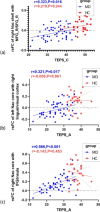Abnormal functional connectivity of the nucleus accumbens subregions mediates the association between anhedonia and major depressive disorder
- PMID: 37085792
- PMCID: PMC10122393
- DOI: 10.1186/s12888-023-04693-0
Abnormal functional connectivity of the nucleus accumbens subregions mediates the association between anhedonia and major depressive disorder
Abstract
Background: The nucleus accumbens (Nac) is a crucial brain region in the pathophysiology of major depressive disorder (MDD) patients with anhedonia. However, the relationship between the functional imaging characteristics of Nac subregions and anhedonia remains unclear. Thus, this study aimed to investigate the role of resting-state functional connectivity (rsFC) of the Nac subregions between MDD and anhedonia.
Methods: We performed resting-state functional magnetic resonance imaging (fMRI) to measure the rsFC of Nac subregions in 55 MDD patients and 30 healthy controls (HCs). A two-sample t test was performed to determine the brain regions with varying rsFC among Nac subregions between groups. Then, correlation analyses were carried out to investigate the relationships between the aberrant rsFC of Nac subregions and the severity of anhedonia. Furthermore, we constructed a mediation model to explain the role of the aberrant rsFC of Nac subregions between MDD and the severity of anhedonia.
Results: Compared with the HC group, decreased rsFC of Nac subregions with regions of the prefrontal cortex, insula, lingual gyrus, and visual association cortex was observed in MDD patients. In the MDD group, the rsFC of the right Nac shell-like subregions with the middle frontal gyrus (MFG)/superior frontal gyrus (SFG) was correlated with consummatory anhedonia, and the rsFC of the Nac core-like subdivisions with the inferior frontal gyrus (IFG)/insula and lingual gyrus/visual association cortex was correlated with anticipatory anhedonia. More importantly, the functional alterations in the Nac subregions mediated the association between anhedonia and depression.
Conclusions: The present findings suggest that the functional alteration of the Nac subregions mediates the association between MDD and anhedonia, which provides evidence for the hypothesis that MDD patients have neurobiological underpinnings of reward systems that differ from those of HCs.
Keywords: Anhedonia; Functional connectivity; Major depressive disorder; Nucleus accumbens subregions.
© 2023. The Author(s).
Conflict of interest statement
The authors have no conflicts of competing interests to declare.
Figures






Similar articles
-
Role of baseline resting-state functional connectivity of the nucleus accumbens subregions in antidepressant treatment in major depressive disorder.Neuroimage Clin. 2025 Jul 8;48:103842. doi: 10.1016/j.nicl.2025.103842. Online ahead of print. Neuroimage Clin. 2025. PMID: 40645040 Free PMC article.
-
Anhedonia correlates with functional connectivity of the nucleus accumbens subregions in patients with major depressive disorder.Neuroimage Clin. 2021;30:102599. doi: 10.1016/j.nicl.2021.102599. Epub 2021 Feb 23. Neuroimage Clin. 2021. PMID: 33662708 Free PMC article.
-
Abnormal functional connectivity of the anterior cingulate cortex subregions mediates the association between anhedonia and sleep quality in major depressive disorder.J Affect Disord. 2022 Jan 1;296:400-407. doi: 10.1016/j.jad.2021.09.104. Epub 2021 Oct 1. J Affect Disord. 2022. PMID: 34606812
-
Nucleus accumbens in the pathogenesis of major depressive disorder: A brief review.Brain Res Bull. 2023 May;196:68-75. doi: 10.1016/j.brainresbull.2023.03.004. Epub 2023 Mar 7. Brain Res Bull. 2023. PMID: 36889362 Review.
-
Common and distinct patterns of intrinsic brain activity alterations in major depression and bipolar disorder: voxel-based meta-analysis.Transl Psychiatry. 2020 Oct 19;10(1):353. doi: 10.1038/s41398-020-01036-5. Transl Psychiatry. 2020. PMID: 33077728 Free PMC article. Review.
Cited by
-
Neural effect of childhood maltreatment on neurovascular coupling in adolescent depression.Eur Child Adolesc Psychiatry. 2025 Apr 3. doi: 10.1007/s00787-025-02708-7. Online ahead of print. Eur Child Adolesc Psychiatry. 2025. PMID: 40178663
-
Reduced Functional Connectivity in Nucleus Accumbens Subregions Associates With Cognitive Changes in Alzheimer's Disease.Brain Behav. 2025 Mar;15(3):e70440. doi: 10.1002/brb3.70440. Brain Behav. 2025. PMID: 40135639 Free PMC article.
-
Role of baseline resting-state functional connectivity of the nucleus accumbens subregions in antidepressant treatment in major depressive disorder.Neuroimage Clin. 2025 Jul 8;48:103842. doi: 10.1016/j.nicl.2025.103842. Online ahead of print. Neuroimage Clin. 2025. PMID: 40645040 Free PMC article.
-
Individualized functional brain mapping machine learning prediction of symptom-change resulting from selective kappa-opioid antagonism in an anhedonic sample from a Fast-Fail trial.J Mood Anxiety Disord. 2025 May 9;11:100126. doi: 10.1016/j.xjmad.2025.100126. eCollection 2025 Sep. J Mood Anxiety Disord. 2025. PMID: 40657347 Free PMC article.
-
Astrocyte-derived dominance winning reverses chronic stress-induced depressive behaviors.Mol Brain. 2024 Aug 27;17(1):59. doi: 10.1186/s13041-024-01134-1. Mol Brain. 2024. PMID: 39192323 Free PMC article.
References
-
- Rizvi SJ, Lambert C, Kennedy S. Presentation and Neurobiology of Anhedonia in Mood Disorders: Commonalities and Distinctions.Curr Psychiat Rep. 2018;20(2). - PubMed
Publication types
MeSH terms
LinkOut - more resources
Full Text Sources

